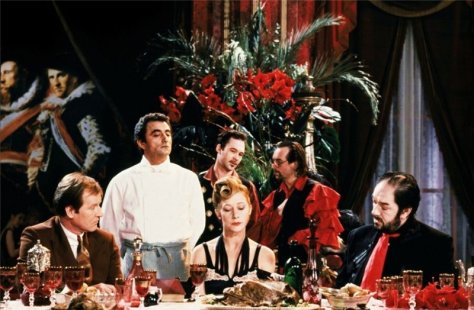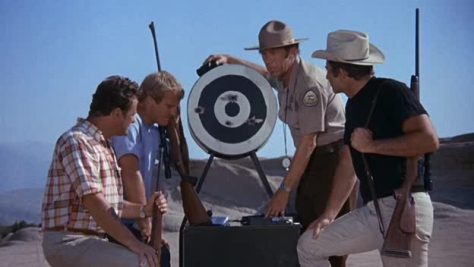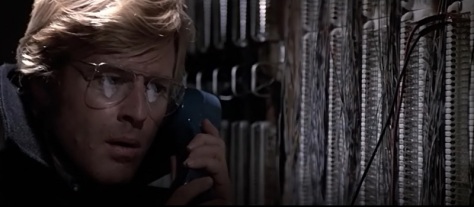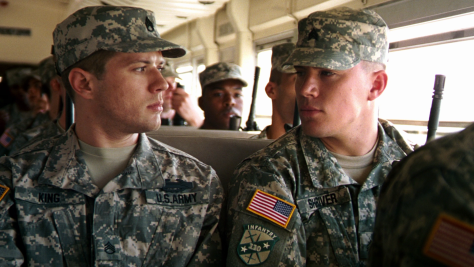By Dennis Hartley
(Originally posted on Digby’s Hullabaloo on October 28, 2023)

(With apologies to Rod Serling for my frightfully tacky paraphrasing) Good evening, and welcome to a private showing of 25 films. Each is a collector’s item in its own way—not because of any special artistic quality, but because each captures on a celluloid canvas, streaming in time and space, a frozen moment of a nightmare. And …Happy Halloween!

Beauty and the Beast (1946)– Out of myriad movie adaptations of Mme. Leprince de Beaumont’s fairy tale, Jean Cocteau’s 1946 version remains the most soulful and poetic. This probably had something to do with the fact that it was made by a director who literally had the soul of a poet (Cocteau’s day job, in case you didn’t know). The film is a triumph of production design, with inventive visuals (photographed by Henri Alekan).
Jean Marais is affecting as The Beast, paralyzed by unrequited passion for beautiful Belle (Josette Day). This version is a surreal fairy tale not necessarily made with the kids in mind (especially with all the psycho-sexual subtexts). The timeless moral of the original tale, however, is still simple enough for a child to grasp: It’s what’s inside that counts.

The Blair Witch Project – Love it or hate it, there is no denying the impact of this cleverly marketed horror flick. In the event that you spent 1999 in a coma, this is the one where a crew of amateur actors were turned loose in dark and scary woods, armed with camping gear, video cameras and a plot point or two provided by filmmakers Daniel Myrick and Eduardo Sanchez, who then proceeded to play creepy, “gotcha” mind games with their young troupe.
The result was surprisingly effective; after all, it’s the perception that “something” in the woods is out to get you that fuels nightmares-not a stunt man in a rubber monster suit lurching about in front of the camera. Arguably, you could cite The Last Broadcast (1998) or relatively more obscure 1980 cult flick Cannibal Holocaust as the progenitors of the “found footage” genre, but The Blair Witch Project took it to a an entirely new level.

Bubba Ho-Tep – This 2002 tongue-in-cheek shocker from Don “Phantasm” Coscarelli could have been “ripped from the headlines”…if those headlines were from The Weekly World News. In order to enjoy this romp, you must unlearn what you have learned. JFK (Ossie Davis) is still alive (long story)…he’s now an elderly African-American gentleman (even longer story). He resides at a decrepit nursing home in Texas, along with Elvis Presley (midnight movie icon Bruce Campbell).
The King and the President join wheelchairs to rid the facility of its formidable pest…a reanimated Egyptian mummy (with a ten-gallon hat) who’s been lurking about waiting for residents to pass on so he can suck out their souls. Lots of laughs, yet despite the over-the-top premise, both Campbell and Davis’ portrayals are respectful; even poignant at times.

Captain Kronos, Vampire Hunter – “What he doesn’t know about vampires wouldn’t even fill a flea’s codpiece!” This unusually droll Hammer entry from 1974 benefits from assured direction and a clever script by Brian Clemens (co-creator of The Avengers TV series). Captain Kronos (Horst Janson) and his stalwart consultant, Professor Hieronymus Grost (John Cater) assist a physician in investigating a mysterious malady befalling the residents of a sleepy hamlet…rapidly accelerating aging.
The professor suspects a youth-sucking vampire may be involved…and the game is afoot. Along the way, the Captain finds romance with the village babe, played by lovely Caroline Munro. The film was released at the tail end of Hammer’s classic period; possibly explaining why Clemens seems to be doing a parody of “a Hammer film”.

Delicatessen– Love is in the air…along with the butcher’s cleaver in this seriocomic vision of a food-scarce, dystopian “near-future” along the lines of Soylent Green, directed with trademark surrealist touches by co-directors Jean-Pierre Jeunet and Marc Caro (The City of Lost Children). The pair’s favorite leading man, Dominique Pinon (sort of a sawed-off Robin Williams) plays a circus performer who moves into an apartment building with a butcher shop downstairs.
The shop’s proprietor seems to be appraising the new tenant with a “professional” eye. In Jeunet and Caro’s bizarre universe, it’s all par for the course (and just wait ‘til you get a load of the vegan “troglodytes” who live under the city). One memorable sequence, a comically choreographed lovemaking scene, stands as a mini-masterpiece of film and sound editing.

Don’t Look Now – This is a difficult film to describe without risking spoilers, so I’ll be brief. Based on a Daphne du Maurier story, this haunting, one-of-a-kind 1974 psychological thriller from Nicholas Roeg (Walkabout, The Man Who Fell to Earth) stars Donald Sutherland and Julie Christie as a couple who are coming to grips with the tragic death of their little girl. Roeg slowly percolates an ever-creeping sense of impending doom, drenched in the Gothic atmosphere of Venice.

Eating Raoul– The late great Paul Bartel directed and co-wrote this twisted and hilarious social satire. Bartel and his frequent screen partner Mary Waronov play Paul and Mary Bland, a prudish, buttoned-down couple who are horrified to discover that their apartment complex is home to an enclave of “swingers”. Paul is even more shocked when he comes home from his wine store job one day and discovers Mary struggling to escape the clutches of a swinger’s party guest who has mistakenly strayed into the Bland’s apartment.
Paul beans him with a frying pan, inadvertently killing Mary’s overeager groper. When the couple discovers a sizable wad of money on the body, a light bulb goes off-and the Blands come up with a unique plan for financing the restaurant that they have always dreamed of opening (and helping rid the world of those icky swingers!). Things get complicated, however when a burglar (Robert Beltran) ingratiates himself into their scheme. Yes, it’s sick…but in a good way.

Ed Wood – Director Tim Burton and his favorite leading man Johnny Depp have worked together on so many films over the last several decades that they are surely joined at the hip by now. For my money, this affectionate 1994 biopic about the man who directed “the worst film of all time” remains their best collaboration. It’s also unique in Burton’s canon in that it is somewhat grounded in reality.
Depp gives a brilliant performance as Edward D. Wood, Jr., who unleashed the infamously inept yet 100% certified cult classic, Plan 9 from Outer Space on an unsuspecting movie-going public in the late 50s. While there are lots of belly laughs, there’s no punching downward at Wood and his decidedly off-beat collaborators; in a way the film is a love letter to outsider film makers. Martin Landau steals his scenes with a droll, Oscar-winning turn as Bela Lugosi. Also with Bill Murray, Sarah Jessica Parker, Patricia Arquette and Jeffrey Jones.

Forbidden Zone – Picture if you will: an artistic marriage between John Waters, Max Fleischer, Busby Berkeley and Peter Greenaway. Now, imagine the wedding night (I’ll give you a sec). As for the “plot”, well, it’s about this indescribably twisty family who discovers a portal to a pan-dimensional…oh, never mind. Suffice it to say, any film that features Herve Villechaize as the King of the Sixth Dimension, Susan Tyrrell as his Queen and soundtrack composer Danny Elfman channeling Cab Calloway (via Satan), is a dream for some; a nightmare for others. Directed by Danny’s brother Richard.

I Married a Witch– Clocking in at 77 minutes, Rene Clair’s breezy 1942 romantic fantasy packs in more wit, sophistication and fun than any ten modern “comedies” you’d care to name put together. I’ll tell you what else holds up pretty well after 80 years…Veronica Lake’s allure and pixie charm. Lake is a riot as a witch who re-materializes 300 years after putting a curse on all male descendants of a Puritan who sent her to the stake.
She and her equally mischievous father (Cecil Kellaway) wreak havoc on the most recent descendant (Fredric March), a politician considering a run for governor. Lake decides to muck up his relationship with his fiancé (Susan Hayward) by making him fall in love with his tormentor. All she needs to do is slip him a little love potion, but her plan fizzes after she accidentally ingests it herself. And yes, hilarity ensues.

J-Men Forever!– Woody Allen may have done it first (What’s Up, Tiger Lily?) and the Mystery Science Theater 3000 troupe has since run the concept into the ground, but Firesign Theater veterans Phil Proctor and Peter Bergman did it best with J-Men Forever.
I am referring to the concept of re-appropriating footage from corny, no-budget B-films and re-dubbing the soundtrack with comic dialogue. I’ve been a devotee of this film since it aired on the USA Network’s after hours cult show Night Flight back in the 80s (alright, raise your bong if you remember that one).
The creators had a sizable archive from the old Republic serials to cull from, so they were not restricted by the narrative structure of one specific film. As a result, Proctor and Bergman’s wonderfully silly concoction about saving Earth from a nefarious alien mastermind called “The Lightning Bug” benefits from quick-cut editing, synced with their trademark barrage of one-liners, puns and double entendre, all set to a rock ‘n’ roll soundtrack. “Schtay high!”

Mulholland Drive – David Lynch’s nightmarish, yet mordantly droll twist on the Hollywood dream makes The Day of the Locust seem like an upbeat romp. Naomi Watts stars as a fresh-faced ingénue with high hopes who blows into La-la Land from Somewhere in Middle America to (wait for it) become a star. Those plans get, shall we say, put on hold…once she crosses paths with a voluptuous and mysterious amnesiac (Laura Harring).
What ensues is the usual Lynch mind fuck, and if you buy the ticket, you better be ready to take the ride, because this is one of his more fun ones (or as close as one gets to having “fun” watching a Lynch film). This one grew on me; by the third or fourth time I’d seen it I decided that it’s one of the iconoclastic director’s finest efforts. Peter Deming’s cinematography is stunning. The truly fascinating cast includes Justin Theroux, Ann Miller, Michael J. Anderson, Robert Forster, Lee Grant, Chad Everett, Dan Hedaya, and, erm, Billy Ray Cyrus.

Multiple Maniacs – Warning: This 1970 trash classic from czar of bad taste John Waters is definitely not for the pious, easily offended or the faint of heart. The one and only Divine heads the cast who became Waters’ faithful “Dreamland” repertory (Edith Massey, Mink Stole, David Lochary, etc.) in a tale of mayhem, filth and blasphemy too shocking to discuss in mixed company (you’ll never see a Passion Play the same way).
Watching this recently for the first time in several decades, I was suddenly struck by the similarities with the contemporaneous films of Rainier Werner Fassbinder (Love is Colder than Death and Gods of the Plague in particular). Once you get past its inherent shock value, Multiple Maniacs is very much an American art film.

The Mystery of the Wax Museum (1933) – “Images of wax that throbbed with human passion!” Get your mind out of the gutter…I’m merely quoting the purple prose that graced the original posters for this 1933 horror thriller, directed by the eclectic Michael Curtiz (Adventures of Robin Hood, The Sea Hawk, Yankee Doodle Dandy, Casablanca, Mildred Pierce, King Creole, et.al.).
Beautiful (and busy) Fay Wray (who starred in King Kong the same year) captures the eye of a disturbed wax sculptor (a hammy Lionel Atwill) for reasons that are ah…more “professional” than personal. Wray is great eye candy, but it is her co-star Glenda Farrell who steals the show as a wisecracking reporter (are there any other kind of reporters in 30s films?). Farrell’s comedy chops add just the right amount of levity to this genuinely creepy tale. A classic.

Night of the Hunter – Is it a film noir? A horror movie? A black comedy? A haunting American folk tale? The answer would be yes. The man responsible for this tough-to-categorize 1957 film was one of the greatest acting hams of the 20th century, Charles Laughton, who began and ended his directorial career with this effort. Like a great many films now regarded as “cult classics”, this one was savaged by critics and tanked at the box office upon its initial release (enough to spook Laughton from ever returning to the director’s chair).
Robert Mitchum is brilliant (and genuinely scary) as a knife-wielding religious zealot who does considerably more “preying” than praying. Before his condemned cell mate (Peter Graves) meets the hangman, he talks in his sleep about $10,000 in loot stashed on his property. When the “preacher” gets out of the slam, he makes a beeline for the widow (Shelly Winters) and her two young’uns. A disturbing tale unfolds. The great Lillian Gish is on board as well. It’s artfully directed by Laughton and beautifully shot by DP Stanley Cortez.

No Such Thing– Director Hal Hartley’s arch, deadpan observations on the human condition either grab you or leave you cold, and this modern Beauty and the Beast tale is no exception. TV news intern Beatrice (Sarah Polley) is sent to Iceland to get an exclusive on a real-life “monster” (Robert Burke), an immortal nihilist who kills boredom by drinking heavily and terrorizing whomsoever is handy.
After her plane goes down en route, her cynical boss (Helen Mirren) smells an even bigger story when Beatrice becomes the “miracle survivor” of the crash. The Monster agrees to come back to N.Y.C. if Beatrice helps him track down the one scientist in the world who can put him out of his misery.
The pacing in the first half is leisurely; dominated by the Monster’s morose, raving monologues, set against the stark, moody Icelandic backdrop (I was reminded of David Thewlis’ raging, darkly funny harangues in Naked). Once the story heads for New York, however, the movie turns into a satire of the art world (a la John Waters’ Pecker), as the couple quickly become celebrities du jour with the trendy Downtown crowd.

Psycho – Bad, bad Norman. Such a disappointment to his mother. “MOTHERRRR!!!” Poor, poor Janet Leigh. No sooner had she recovered from her bad motel experience in Touch of Evil than she found herself checking in to the Bates and having a late dinner in a dimly lit office, surrounded by Norman’s unsettling taxidermy collection. And this is only the warm up to what Alfred Hitchcock has in store for her later that evening (anyone for a shower?).
This brilliant thriller has spawned so many imitations, I’ve lost count. While tame by today’s standards, several key scenes still have the power to shock. Twitchy Tony Perkins sets the bar for future movie psycho killers. Joseph Stefano adapted the spare screenplay from Robert Bloch’s novel. Also in the cast: Vera Miles, John Gavin, Martin Balsalm, and Simon Oakland.

The Rocky Horror Picture Show – Speaking of Fay Wray…50 of years of midnight showings have not diminished the cult status of Jim Sharman’s film adaptation of Richard O’Brien’s stage musical about a hapless young couple (Barry Bostwick and Susan Sarandon) who have the misfortune of stumbling into the lair of one Dr. Frank-N-Furter (Tim Curry) one dark and stormy night. O’Brien co-stars as the mad doctor’s hunchbacked assistant, Riff-Raff.
Much singing, dancing, cross-dressing, axe-murdering, cannibalism and hot sex ensues-with broad theatrical nods to everything from Metropolis, King Kong and Frankenstein to cheesy 1950s sci-fi, Bob Fosse musicals, 70s glam-rock and everything in between. Runs out of steam a bit in the third act, but the knockout musical numbers in the first hour or so makes it worth repeated viewings.

Rosemary’s Baby – “He has his father’s eyes!” Roman Polanski put the “goth” back in “gothic” in this devilish 1968 metropolitan horror classic. A New York actor (John Cassavetes) and his young, socially phobic wife Rosemary (Mia Farrow) move into a somewhat dark and foreboding Manhattan apartment building (the famed Dakota, John Lennon’s final residence), hoping to start a family. A busybody neighbor (Ruth Gordon) quickly gloms onto Rosemary with an unhealthy zest (to Rosemary’s chagrin). Her nightmare is only beginning. No axe murders, no gore, and barely a drop of blood…but thanks to Polanski’s impeccable craft, this will scare the bejesus out of you and continue to creep you out after credits roll. Polanski adapted the screenplay from Ira Levin’s novel.

The Shining – “Hello, Danny.” It has been said that Stephen King hated Stanley Kubrick’s adaptation of his sprawling novel about a family of three who hole up in an isolated Rocky Mountain hotel for the winter. Well-that’s his personal problem. I think this is the greatest “psychological” horror film ever made…period (OK that’s a bit hyperbolic-perhaps we can call it “a draw” with Polanski’s Repulsion).
Anyway…Jack Nicholson discovers that all work and no play make Jack a dull boy. Jack Nicholson discovers that all work and no play make Jack a dull boy. Jack Nicholson discovers that all work and no play make Jack a dull boy. Jack Nicholson discovers that all work and no play make Jack a dull boy, etc.

The Shout – This unsettling 1978 sleeper was adapted from a Robert Graves story by Michal Austin and its director, Jerzy Skolimowski. The late John Hurt is excellent as a mild-mannered avant-garde musician who lives in a sleepy English hamlet with his wife (Susannah York). When an enigmatic vagabond (Alan Bates) blows into town, their quiet country life begins to go…elsewhere. This is a genre-defying film; somewhere between psychological horror and culture clash drama. I’ll put it this way-if you like Peter Weir’s The Last Wave (which would make a great double-bill) this one is in your wheelhouse.

Siesta – Depending on who you ask, Mary Lambert’s 1987 thriller is either a compelling riddle, wrapped in a mystery, inside an enigma…or an unfinished film in search of a narrative. It was not well received by critics, but has a modest cult following, of which I am a card-carrying member.
Ellen Barkin stars as an American daredevil who wakes up on a deserted runway in Spain, dazed, bruised and confused. As she wanders about getting her bearings, pieces of her memory return. She encounters assorted characters in increasingly weird scenarios. The film lies somewhere between Carnival of Souls and Memento.
Also with Gabriel Byrne, Julian Sands (who passed away this year), Isabella Rossellini, Martin Sheen, Grace Jones, and Jodie Foster. Patricia Louisiana Knop (9½ Weeks) adapted the screenplay from Patrice Chaplin’s novel. Atmospheric score by Miles Davis. Long out-of-print on DVD, this is a film begging for a Blu-ray release (should any boutique reissue label folks be reading this…hint, hint!).

Trollhunter – Like previous entries in horror’s “found footage” sub-genre, Trollhunter features an unremarkable, no-name cast; but then again you don’t really require the services of an Olivier when most of the dialog is along the lines of “Where ARE you!?”, “Jesus, look at the size of that fucking thing!”, “RUN!!!” or the ever popular “AieEEE!”.
Seriously, though- what I like about Andre Ovredal’s film (aside from the convincing monsters) is the way he cleverly weaves commentary on religion and politics into his narrative. The story concerns three Norwegian film students who initially set off to do an expose on illegal bear poaching, but become embroiled with a clandestine government program to rid Norway of trolls who have been terrorizing the remote areas of the country (you’ll have to suspend your disbelief as to how the government has been able to “cover up” 200 foot tall monsters rampaging about). The “trollhunter” himself is quite a character. And always remember: while hunting trolls…it’s best to leave the Christians at home!

Ugetsu Monogatari – Kenji Mizoguchi’s eerie 1953 ghost story/morality tale was adapted from several short stories by 18th-Century writer and poet Ueda Akinari.
The story is set in 16th-Century Japan, in the midst of one of the civil wars of the era. A potter of modest means and grandiose financial schemes (Masayuki Mori) and his n’er do well brother (Eitaro Ozawa) who fantasizes about becoming a renowned samurai warrior ignore the dire warnings of a local sage and allow their greed and ambition to take full hold, which leads to tragic consequences for their abandoned wives (Mitsuko Mito and Kinuyo Tanaka).
Beautifully acted; particularly strong performances by the three female leads (Mito, Tanaka, and the great Machiko Kyo as the sorceress Lady Wakasa). It’s a slow-burning tale, but if you just give it time the emotional wallop of the denouement will floor you.

Young Frankenstein – Writer-director Mel Brooks’ 1974 film transgresses the limitations of the “spoof” genre to create something wholly original. Brooks goofs on elements from James Whale’s original 1931 version of Frankenstein, his 1935 sequel, Bride of Frankenstein, and Rowland V. Lee’s 1939 spinoff, Son of Frankenstein.
Gene Wilder heads a marvelous cast as Dr. Frederick Frankenstein (pronounced, “Franken-schteen”) the grandson of the “infamous” mad scientist who liked to play around with dead things. Despite his propensity for distancing himself from that legacy, a notice of inheritance precipitates a visit to the family estate in Transylvania, where the discovery of his grandfather’s “secret” laboratory awakens his dark side.
Wilder is quite funny (as always), but he plays it relatively straight, making a perfect foil for the comedic juggernaut of Madeline Khan, Marty Feldman, Peter Boyle, Cloris Leachman (“Blucher!”), Terri Garr and Kenneth Mars, who are all at the top of their game. The scene featuring a non-billed Gene Hackman (as an old blind hermit) is a classic.
This is also Brooks’ most technically accomplished film; the meticulous replication of Dr. Frankenstein’s laboratory (utilizing props from the 1931 original), Gerald Hirschfeld’s gorgeous B & W photography and Dale Hennesy’s production design all combine to create an effective (and affectionate) homage to the heyday of Universal monster movies.



















 Since it’s Thanksgiving weekend, that most venerable of American holidays which enables families to gather once a year to count their blessings, stuff their faces, and endeavor mightily to not bring politics into the conversation, I thought I might mosey on over to the movie pantry and hand-select my top 10 food films. Dig in!
Since it’s Thanksgiving weekend, that most venerable of American holidays which enables families to gather once a year to count their blessings, stuff their faces, and endeavor mightily to not bring politics into the conversation, I thought I might mosey on over to the movie pantry and hand-select my top 10 food films. Dig in!















































































_630_355_90.jpg?ssl=1)











